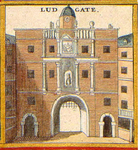Bell Savage Inn
Buildings and structures demolished in 1873Coaching innsDefunct hotels in LondonFormer buildings and structures in the City of LondonFormer pubs in London ... and 5 more
Former theatres in LondonInn-yard theatresPubs in the City of LondonTheatres completed in 1575Use British English from May 2015

The Bell Savage Inn was a former public house in London, England, from the 15th century to 1873, originally located on the north side of what is now Ludgate Hill, in the City of London. It was a playhouse during the Elizabethan Era, as well as a venue for various other entertainments. It was also an important coaching inn. Other names by which it has been known throughout history include: Savage's Inn, The Bel Savage, Belle Savage, Belle Sauvage, Bell on the Hoop, Old Bell Savage, Belly Savage and others.
Excerpt from the Wikipedia article Bell Savage Inn (License: CC BY-SA 3.0, Authors, Images).Bell Savage Inn
Ludgate Hill, City of London
Geographical coordinates (GPS) Address Nearby Places Show on map
Geographical coordinates (GPS)
| Latitude | Longitude |
|---|---|
| N 51.514166666667 ° | E -0.10361111111111 ° |
Address
City Thameslink Station / Ludgate Circus
Ludgate Hill
EC4M 7JH City of London
England, United Kingdom
Open on Google Maps









